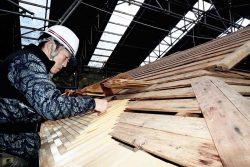
Roads are seen radially stretching out from Den-en-chofu Station in 1932. This city plan was designed by Eiichi Shibusawa’s fourth son, Hideo, after he toured Western countries. Similar road patterns are seen around the Arc de Triomphe in Paris.
12:43 JST, January 26, 2021
The Den-en-chofu area in Ota Ward, Tokyo, is known as one of the capital’s most prestigious residential areas. Given that “den-en,” is a part of its name, some may think it to be located along Tokyu Corp.’s Den-en-toshi Line, however the train lines that run through the area are actually Tokyu’s Toyoko and Meguro lines.
So, from where does the area take its name?
Near Den-en chofu Station’s West Gate stands a reproduction of the original European-style station that was constructed in the Taisho era (1912-1926). From there, roads lined with ginkgo trees radially extend through the surrounding residential area. Den-en chofu’s “den-en” as its written in kanji can be translated as a garden or country view. Even so, can the area’s current landscape be described as having the tranquility of its namesake? Some don’t believe so.

A reproduction of the original Den-en-chofu Station building constructed in the Taisho era is seen where the present-day station is located underground.
Takahisa Tsukiji, a curator of a ward-run folk museum, said, “In the Meiji era [1868-1912], this was a farming area called Chofu Village in Ebara County. Looking at maps from that time, wooded areas and farming fields were abundant.”
“Chofu,” is said to originate from “cho,” which was a form of tax in the Nara period (710-794), and “fu” meaning clothes that were once blanched in the Tama River.
Geographical names that contain the word chofu are seen in many places along the Tama River, including Chofu City.
“The development and sale of Tamagawadai Jutakuchi, a suburban-style residential area, in the Taisho era was the beginning of the Den-en-chofu residential area,” Tsukiji said.
Den-en-toshi Co., one of the predecessors of Tokyu Group, was the entity that set the development of the residential area in motion. The company was established in 1918 (the seventh year of the Taisho era) to develop the areas that eventually became the Ookayama and Senzoku districts, straddling Meguro, Ota and Shinagawa wards, as well as the Den-en-chofu area.
Company founder Eiichi Shibusawa (1840-1931) was an industrialist dubbed “the father of Japanese capitalism.”
According to Seien Kaikoroku, a biography of Shibusawa published in 1927, contains remarks made by the man himself including, “Mankind cannot live without the existence of nature” and “Even as I watched Tokyo’s extremely high-paced expansion, I have hoped that our nation will create something akin to a garden city to supplement, even if partially, the faulty points in urban lifestyles.”
During those years, central Tokyo’s population skyrocketed, making living conditions a social problem.
Den-en-toshi Co. was influenced by the concept of a garden city, proposed by England-born Ebenezer Howard, as a way to resolve problems in London, which at the time was also excessively populated.
The company aims to create towns in Tokyo suburban areas that harmonize with natural environments.
To bring such living environments to fruition, the company requested that those who bought land plots comply with such rules as not constructing buildings that may become a bother for other people, that houses and other buildings should stand three stories tall at maximum, and that a house’s premises should not occupy more than 50% of the residential land’s acreage.
The Tamagawadai residential area began selling land in 1923 following the example of the Senzoku area. A large number of people moved into these new residential areas partly to escape the damage in the central part of Tokyo caused by the Great Kanto Earthquake in the same year.
In that same year, the Meguro-Kamata Electric Railway opened as a resident commuting service. According to Tokyu, the station in the Tamagawadai residential area was initially named as “Chofu” after the village in the area.
However, it became necessary to distinguish it from a station of the then-Japanese National Railway with the same name. Therefore three years later, the word den-en was added to the station’s name, becoming Den-en-chofu Station.
Den-en-toshi Co. ended its sale of residential land plots and was later absorbed into Meguro-Kamata Electric Railway Co.
At the same time, an association of residents who moved into the area in its early years became an incorporated association called the Den-en-chofu-kai, which has proactively worked to secure good living conditions.
But the association faced many problems including surging land prices in Japan’s postwar economic growth period, segmentation of land plots along with generational changes, and resident turnover.
In 1982, the association established its seven-point Den-en-chofu charter in order to make the spirit and ideals of Mr. Shibusawa regarding the creation of towns known and as a way of inheriting the tradition of self-governance and cooperation.
To enact the charter’s practical points, association members agreed to take such measures as limiting the heights of their houses.
The Ota Ward Office accepted requests and implemented measures since 1991. For example, the ward office restricts developments in which a single land plot is divided into segments under about 165 square meters in some areas within the Den-en-chofu district.
Related Tags
"Features" POPULAR ARTICLE
-

Students Recreate 19th-Century Bento Boxes Made for Ino Tadataka’s Survey Team in Hot Spring Town on Nakasendo Road
-

Santa Claus Delivers Christmas Presents to Penguins at Aquarium in Japan’s Nagasaki Prefecture
-

Sumo Restaurant in Tokyo Teaches Foreign Visitors About the Ancient Sport, with Bouts Between Retired Rikishi
-

Autonomous Passenger Ship Connects Mainland with Remote Island in Seto Inland Sea; World’s 1st Commercially Operated Autonomous Vessel
-

Osaka’s Sumiyoshi Taisha Shrine Bustles with New Year’s Visitors
JN ACCESS RANKING
-

As Chinese Tourists Shun Japan, Hotels and Stores Suffer
-

Osaka-Kansai Expo’s Economic Impact Estimated at ¥3.6 Trillion, Takes Actual Visitor Numbers into Account
-

Japan Govt Adopts Measures to Curb Mega Solar Power Plant Projects Amid Environmental Concerns
-

BOJ Gov. Ueda: Highly Likely Mechanism for Rising Wages, Prices Will Be Maintained
-

Economic Security Panels Debate Supply Chains, Rare Earths; Participants Emphasize Importance of Cooperation Among Allies

























